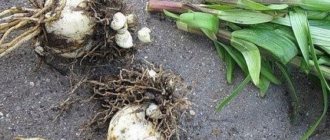Lilies are the most beautiful flowers, known for more than a thousand years. They carry extraordinary beauty and pure energy. There are many varieties of lilies that differ in color, flower shape, and aroma. These wonderful flowers can be seen in landscape landscaping; they are the main decorative attribute. But novice gardeners are afraid to grow flowers on the plot, believing that flowers are too capricious. This is wrong. If you know how to store lilies in winter at home, breeding fragrant beauties will not be difficult.
Storage conditions for lily bulbs in winter
Compliance with storage conditions will help preserve lily bulbs for the winter without loss.
- It is necessary to maintain optimal temperature conditions.
- The room where the bulbs will be stored must be sufficiently humid, otherwise they will lose moisture and shrink.
- If the humidity in the room is very high, the bulbs may germinate prematurely or begin to rot.
- The room must be ventilated. Without access to fresh air, mold and all kinds of fungi may appear on the bulbs, which will then lead to the development of the disease.
Reproduction during storage
In winter, when storing the bulbs, they can be propagated. This procedure is performed using scales. They are very carefully removed from the bulb and converted into potassium permanganate or some kind of fungicide. After this, they are dried and placed in bags with a peat composition. Then store in the same way as the rest of the onions.
By spring, the separated scales are covered with small bulbs, the diameter of which does not exceed 1 cm; they are carefully separated and planted in a permanent place.
On a note!
Some people place young bulbs in a mixture of peat and sand. They will then grow when they land.
How to prepare lily bulbs for storage
Experienced gardeners do not recommend trimming the foliage of lilies and stems after flowering. This will allow the bulbs to be saturated with useful substances for flowering in the summer. As soon as the shoots wither, and this happens in late autumn, you can start harvesting. After the period of planting a lily flower, it takes 1.5 months to rest. After flowering, the ovary must be cut off.
The signal for digging lily bulbs out of the soil for storage is the first winter frosts. At this time, cut off the dry stem, leaving about five centimeters. For digging, use a pitchfork, not a shovel. They make a neat slit in a circle, and then carefully remove the bulb from the soil. It is shaken off the ground, then washed under cold water. The bulbs are placed loosely in a container to dry. Some gardeners place moss between the bulbs.
It is recommended to conduct a thorough inspection of the flowers for the presence of affected and putrefactive areas and diseases. Damaged material must be sifted out. Place the tray with the bulbs in a cool, dark place, where they can dry out in two days; if the temperature is too high, mold and mildew may form.
After drying, the bulbs must be sprayed with fungicidal powder. The prepared planting material is placed in paper bags; you can simply wrap each lily in newspaper several times. The bulbs are placed in a cardboard box along with moss or sawdust, in which holes need to be made for ventilation. The place for wintering can be any - balcony, basement, garage.
Preparation
When understanding the question of how to store lily bulbs correctly, it is important to understand that they need to be properly prepared:
- all bulbs must be washed off the ground under running water;
- conduct a thorough inspection of the seed, discarding all damaged specimens and those with traces of rot or fungus;
- leave the onions to dry at a temperature of +15 °C to +18 °C.
After the lilies are completely dry, they must be sprinkled with fungicide for disinfection.
Careful preparation is the key to ensuring that the bulbs can last until spring and not lose their properties.
How to preserve lilies for the winter. Storage methods
How to preserve lily bulbs before planting? There are several storage options. If the plant has sprouted, but it is too early to plant it, you need to plant it in flowerpots. Then place in a cool, well-lit place to slow down growth.
You can place the bulbs in plastic bags, puncturing small holes in them to allow air to enter. A layer of peat is placed at the bottom, with lilies on them. There must be a peat layer of at least 10 cm between the plants. The bag is tied, placed in a container or cardboard box and placed in a storage place.
Peat planting pots are also suitable for storage. The containers are placed in a container and placed for storage in the selected location. The method is the most practical and convenient, since planting can be done immediately along with the pots. Before planting, place the flowerpots in a warm, illuminated place and begin watering.
Resuscitation of lily bulbs
If storage conditions are violated, lily bulbs can deteriorate - lose moisture or become soft. There are a number of ways to resuscitate seed:
- The lily has dried out due to high temperature - wrap the bulbs with a piece of gauze soaked in a solution of potassium permanganate (0.5%). In a few days they can be planted.
- The onion has become soft - leave it in the growth stimulator solution for 1 day.
- The appearance of rotten areas - areas of damage are removed, the living area underneath is treated with pharmaceutical green.
If the onion is frozen, it can only be restored if hard spots are felt on it.
The frozen parts are cleaned off, the bulb is placed in a growth stimulator for a day, and then sent back for storage in dry peat.
How to choose storage space
Storage location is important for the safety of lilies. The temperature regime is important and must be constant. It is best if the temperature is at 0...+4°C. Experienced gardeners do not recommend storing lily bulbs in the refrigerator, since there is not enough ventilation there. As practice shows, such storage significantly reduces the supply of planting material.
It is most convenient to store lilies in a cellar or basement. They are ideal because they can easily achieve the required temperature, ventilation and humidity levels. During the winter, it is necessary to take into account what the air temperature is outside in order to open or close the ventilation duct as necessary.
Tips for caring for lilies during storage
To obtain high-quality planting material in the spring, it is necessary to store lilies correctly in winter:
- Regularly ventilate the room and containers where the bulbs are located.
- Inspect and remove diseased specimens, since one such tuber can infect all the others with fungus.
- Maintain optimal humidity and air temperature.
- When storing outdoors in severe frosts, you need to strengthen the cover with agrofibre.
Read more Pruning lilies in the fall after flowering for beginners: timing, video
Most often, bulbous plants are affected by fusarium, the main symptoms of which include blurry, red spots on the tubers. The reason for this pathology is high humidity and insufficient ventilation. If diseased specimens are found, they are removed and disposed of.
With a lack of moisture in the air, the bulbs wither and become loose. Most often, this problem occurs when stored in the refrigerator, open boxes or containers. Sawdust, peat, and paper should sometimes be moistened to prevent drying out.
If a fusarium disease is suspected, the tubers are immediately removed from the general storage area.
How to store lilies in winter at home
In a refrigerator. Storing lily bulbs at home is possible in the refrigerator. The bulbs are placed in a bag into which damp peat is poured. The bag with planting material is stored on the bottom shelf of the refrigerator. It should be taken into account that when storing lilies in the refrigerator, you cannot store fruit there. They emit ethylene, which is harmful to lilies.
In the basement, garage. These rooms are suitable only when they are sufficiently insulated and the temperature in them, even in severe frosts, does not fall much below zero. A layer of sand or peat is poured into a container (container or box), it should be slightly damp. A layer of bulbs is placed on this layer and covered again with sand or peat. You can make several layers, the top layer should be a covering layer. The container is covered with damp burlap.
On the loggia or balcony of the apartment. How to store lily bulbs in winter? You can install a box with thermal insulation on the balcony. The body of an old refrigerator is suitable, which is installed near the wall of the building to get additional protection from frost. It should be taken into account that in severe frost the bulbs may freeze. Handymen can upgrade an old refrigerator box by installing a thermometer inside to monitor the temperature and a few incandescent light bulbs that can act as heaters when the temperature drops.
Other methods
A number of other methods that are often practiced by gardeners can be used to store bulbous material.
In the package
Bulbs can only be kept in a bag if there are plenty of holes in it to ensure ventilation. Sawdust with peat or sand is poured into the bottom of the bag.
In the bag, the bulbs are placed in only 1 layer. It is not necessary to place such a container in a cold place. They are kept on the balcony or underground.
Use of stockings
In the stocking, lilies are placed in several layers. The stocking itself is hung in a cool, dry room where the temperature does not exceed +5 °C.
The advantage of this method is that the material allows you to keep the bulbs dry and provides them with the necessary ventilation
Containers
Lilies that began to germinate in the middle of winter are stored in pots or flowerpots. They are placed in pots with nutritious soil at the bottom and left in a cool place.
As soon as sprouts begin to appear, the container must be placed in a place with abundant but diffused sunlight. Digging up the bulbs for further moving them to the garden bed is done with extreme caution so as not to damage the root system.
In boxes
Holes are made in the boxes for ventilation, and the bulbs are sprinkled with sawdust or peat. Containers are kept in cool rooms where the temperature is stable.
In paper bags
Lilies are placed in paper bags, or simply wrapped in paper. This material allows you to retain the necessary moisture inside the seed. Paper bags are placed in boxes and stored in a cool place where there is no access to sunlight.
In peat bags
The bulbs are planted in peat pots filled with nutritious soil and left in a dark, cool place. Planting in peat containers is advantageous in that the lilies are then planted in the ground directly in peat pots.
After planting, there is no need to water the bulbs in a peat container.
Peat gradually decomposes and serves as an excellent fertilizer.
Is it possible to leave the bulbs in the ground?
Many gardeners are interested in whether it is right to constantly dig up bulbs? In fact, for high-quality storage, about 15 cm of snow cover is enough, only in this case the lilies will not freeze. And without snow, there is a risk that the bulbs left in the ground will simply die.
Although in warm regions, flower growers leave lilies for the winter at their place of growth. But it’s better to play it safe by covering the beds with peat, spruce branches, and pine paws. Coniferous covering is the most optimal, since in the spring there will be no breeding ground for pests. At the first thaw in early spring, the covering must be removed.
It should be remembered that this storage method is only suitable for frost-resistant varieties. When growing Oriental Trumpet varieties and other oriental hybrids, it is necessary to ensure that they are in dry soil at the time of the first rainfall. In the first week of September, you can cover the beds with polyethylene and remove it when the first frosts hit.
Is it possible to winter lilies in open ground?
Lilies will not freeze in the ground if the snow cover is at least 15 cm high, and if there is no snow in the frost, the bulbs will most likely die.
In the southern regions, many gardeners do not dig up flowers for the winter, but simply cover them with peat or spruce branches. The needles will prevent the development of harmful microflora and will preserve planting material until spring shoots. The branches are removed with the onset of stable heat.
It is possible to safely store lilies outdoors in winter only if they are frost-resistant. Even the most capricious varieties of these flowers will delight you with bright colors and aromas if you know how and where to store lilies in winter.
Covering lilies for overwintering
Sometimes you don't just need to preserve the lily bulbs that you dug up yourself. There are times when planting material was purchased for the winter and needs to be preserved. Oriental hybrids of different varieties of representatives of the Liliaceae family are recommended to be covered. To do this, you need to make a trench in the garden plot. You need to choose a place for it where it is dry and sunny in spring, and where a lot of snow lingers in winter. High-quality drainage will help avoid stagnation of water in the trench. Line the trench with boards and make a cover.
Place the lily bulbs in bags, pack them, put them in a trench, transferring them with bags of water. They will be an excellent temperature indicator and maintain atmospheric changes. If the water freezes in the cold, it means the bulbs will begin to freeze. The storage is first covered with film, then closed with a lid. You can add a layer of cardboard on top, sprinkle with earth, and cover with pine branches. To protect the material from mice, it is necessary to spread rodent poison in the trench.
What planting material to buy
Lily bulbs appear on sale from the last days of January to May. And also from the end of August to September. The fresher they are, the more likely it is that the bulbs will germinate quickly and the plants will bloom quickly.
- If you purchase lilies in the fall, you should give preference to products from domestic producers. And from February to March you can already buy imported products.
- When purchasing, you need to evaluate the appearance and structure of each light bulb. There should be no damage or signs of disease. They should be firm to the touch, with no soft spots.
- It is very important that the planting material does not emit a musty smell when opening the package.
- Another indicator of the quality of lily bulbs is the presence of living roots. If the bulbs are purchased in the spring, the presence of a small sprout is normal.
- When the bulbs are clearly too dry or too soft, have no roots, or, on the contrary, are sprouting very actively, it is not recommended to buy them. The lilies were most likely stored in violation of the rules, after which they will no longer be able to please with lush and bright flowering.
It is very important to carefully examine the bottom of the bulbs. They should be dry and dense, without signs of fungal infection.
Typical mistakes of beginning gardeners
The main errors are related to inappropriate storage conditions:
- Low storage temperatures slow down the formation of flower buds. This can slow down the flowering process or even eliminate it.
- At low humidity, the bulbs quickly become unsuitable for planting because they dry out.
- At high humidity, planting material becomes moldy and may rot.
- If the storage area is too warm, the bulbs will begin to grow prematurely.
- During winter, be sure to check the bulbs. If mold appears, you need to wipe the planting material with a damp cloth and sprinkle the affected areas with charcoal.
- When rot appears, it is removed with a knife, treating the cut areas with a solution of brilliant green. If the bulbs are severely damaged, they are thrown away.
Errors and possible problems
Even experienced gardeners often make mistakes that lead to problems:
- If the bulbs are not sufficiently dried before storing, they may rot.
- Damaged scales often become a gateway for infection, so you need to remove them using a sharp knife with a disinfected blade and treat the sections with brilliant green or a fungicide solution.
- Whole and healthy tubers should be stored separately from damaged ones.
- In a room with dry air, the best storage medium for bulbs is soil.
- An increase in ambient temperature stimulates germination, so it must be reduced so that the flower buds remain dormant.
Which lilies should you dig up?
Almost all varieties of these flowers are frost-resistant. But you need to find out whether the plant belongs to hybrid forms. It is imperative to dig up lilies for the winter if they are of varieties such as oriental, American, trumpet and Asian.
And hybrids of LA lilies must be dug up and replanted every year in any climate, since secondary flowering is difficult to obtain without this agrotechnical technique. These varieties quickly produce many babies, which take away nutritional components.
For the winter, you should not dig up the Pennsylvania and Asian hybrid, matragon, candidum, Daurian lily and OA hybrid. Tiger lily is frost-resistant. Other varieties require mulching the soil with a thick layer of sawdust or spruce paws. And the next layer is a protective cover.
LiveInternetLiveInternet
Although lilies, at first glance, may seem like very exotic plants, they are quite hardy and can withstand wintering outside in many regions (frost hardiness zones 5 - 9). However, gardeners in cooler, wetter climates prefer to dig up their lily bulbs for the winter and place them in less harsh environmental conditions. You can also try leaving them in the ground, providing them with extra protection, such as covering the soil with humus or straw, or covering them with plant covers. This article describes all these methods - to learn more, just start reading.
1
.
Dig up lily bulbs after the first frost. If you live in a cooler climate but have lilies growing outside in your garden, be prepared to dig up the plants for the winter. This will increase their chances of survival during the winter.
- Wait until the first frost to dig up your lily bulbs. Before digging, cut off dead shoots (foliage) at a distance of approximately 7.5 cm from the ground.
- Digging up and storing the bulbs indoors during the winter is important for some finicky lily varieties, such as the delicate colored calla lilies.
2. Carefully dig out the bulbs.
Dig a hole much wider than the root itself - this is necessary so as not to touch the bulb with a spatula and damage it.
- Very carefully remove as much soil from healthy bulbs as possible without damaging the roots.
- Rinse the bulbs under cool running water (such as with a garden hose) to remove any remaining soil.
3. Check the bulbs carefully for rot or disease.
There is no point in storing diseased or damaged bulbs. If you find them, throw them away. Avoid composting infected plants as this may spread the infection.
4. Place the bulbs on a tray (tray) and let them dry for a few days.
Make sure there is enough space on the tray for the bulbs to allow air to circulate freely. A cool, dark place like a shed or garage is best for drying the bulbs.
- Do not bring the bulbs into a heated house to dry, as sudden changes in temperature can harm them. Additionally, mold can grow quickly in warm environments.
- Temperature 15 – 20 ̊С is ideal. The bulbs should not be exposed to sunlight.
5. Sprinkle the bulbs with fungicidal powder and place them in storage.
After the bulbs have dried for a few days, sprinkle them with fungicidal powder. Place them in paper bags along with a small amount of dried peat moss or vermiculite.
- You can also use a cardboard box, as long as you make some ventilation holes to allow air to circulate freely inside.
- Make sure the bulbs don't touch each other - you can put moss or vermiculite between them to prevent them from touching. The point is to prevent one bulb from infecting another if rotting begins.
6. Store the bulbs in a dark, dry place.
Moisture and rot are the two biggest dangers to bulbs in winter, so protect them by storing them in a dry, dark place.
- However, you should not allow the bulbs to dry out completely. If the bulbs do become completely dry or wrinkled, lightly spray them with water to prevent them from drying out.
7. Transplant the bulbs outside in mid to late spring.
The bulbs need to rest for several months before they begin to grow again. Therefore, it is best to replant them in mid- or late spring, as soon as the danger of frost has passed and the ground has warmed up.
- Your lilies are even more at risk of being killed by winter rains than by frost, so avoid planting lilies in wet (flooded) soil, even if the weather is good.
ist
If you want to force bulbs from overwintering at home, you should take into account the fact that only properly prepared and full-fledged bulbs (large, healthy bulbs two to three years old) are suitable for forcing. When forced, small and young bulbs do not form good flowers or will not bloom at all. You also need to keep in mind that for successful forcing of various bulbs, you need to adhere to the timing and technology of planting bulbs of this type, observe the storage conditions of planted bulbs and their optimal maintenance during the period of budding and flowering. This is a big topic for separate articles (for example, about forcing daffodils and tulips, about forcing lilies)
The task of preserving flower bulbs in winter at home sooner or later arises for all bulb lovers. Therefore, various methods for reliable storage of bulbs in winter are always in demand by gardeners.
I would like to share a method developed based on personal experience for storing flower bulbs using peat throughout the winter and early spring (until mid-April).
A favorable environment in which flower bulbs can be successfully stored in winter must satisfy several conditions. It should not be too dry (otherwise the bulbs will lose a lot of moisture, wrinkle or dry out completely) or too humid (then the bulbs will become moldy or hatch at the wrong time), it should not be too cold (otherwise the bulbs will freeze) or too warm (then the bulbs will move ahead of time). in height). It is advisable that the room where the bulbs are stored is sufficiently ventilated, otherwise stagnant air can lead to the formation of mold and diseases in the bulbs.
I store flower bulbs in winter using peat in a dry, cold underground with two ventilation holes. The storage facility maintains a low positive temperature (+ 1...+3 degrees) and the required humidity (40-45%).
For winter storage of bulbs, I use a reliable plastic bag; For the purpose of ventilation, I make rare small holes of a few mm in it. At the bottom of the bag, I first pour a peat bedding about 10 cm thick. I lay the onions on the peat in an even layer, slightly retreating from the edges of the bag. I fill the layer of bulbs on top with the same peat moss, but in a thicker layer (12-13 cm), so that the rows of bulbs are spaced apart from each other and the bulbs can breathe normally. Then I place the next row of bulbs on top again. After laying and filling the bulbs with peat, you need to tie the bag and place it in a box or any container suitable for the size of the bag.
It is important to constantly monitor the temperature in the storage and regulate it using the ventilation openings - closing or opening them as necessary, so that the optimal temperature inside is always maintained. Under favorable storage conditions, the bulbs will be at rest, will be perfectly preserved and will not grow ahead of time.
In winter, once a month I inspect the planting material: I untie the bag, remove several bulbs from the top, middle and bottom rows for selective control. I inspect these bulbs for rot, mold or drying out.
As a rule, under favorable storage conditions, healthy bulbs do not die.
If during the inspection a lesion is detected in at least one control bulb, then it will be necessary to check all the planting material in the bag. Then all the stored bulbs must be sorted out and examined very carefully in order, if necessary, to remove dead bulbs and put the affected bulbs in order.
Diseased bulbs should be placed separately from healthy bulbs for subsequent processing and treatment: - mold that has formed should be removed from the bulbs with a dry, clean cloth, and powder these places with crushed charcoal; - remove foci of putrefaction from the bulbs with a sharp, disinfected knife until healthy tissue is removed, and treat the sections with green paint.
The treated bulbs are put back into storage, preferably separately from healthy bulbs and with peat replaced.
Storing bulbs in winter can be successfully combined with propagating your favorite plants. For example, if you dug up bulbs of non-winter-hardy lilies from the garden in the fall, and also purchased bulbs of expensive and rare varieties of lilies too late in the fall (or too early in the spring), then during storage they can be propagated at the same time. In winter, I use a simple method of propagating lilies by scales, so that I can get many children from one bulb.
To do this, I take the onion and dissect it: carefully grabbing each scale with my fingers and trying not to damage its tissue, I carefully separate the scales from the base of the onion. I immediately sprinkle the scales broken off from the onion with peat. I store prepared lily bulbs and scales in the same conditions as described above. Babies soon begin to form at the bases of the broken scales. By the beginning of the gardening season, from a purchased large lily bulb in this way, you can get a large number of young baby bulbs with a diameter of up to 1 cm over the winter. In this case, even if you purchase a lily bulb of a rare and expensive variety (200-300 rubles per piece), then when you propagate it by scales in a year, your expenses will more than pay off due to the receipt of a large amount of valuable planting material.
Pyotr Samsonovich Kiselev (Istra, Moscow region)
ist
Agricultural techniques
Growing lilies is a complex process that includes various agricultural techniques. Each of them has a specific meaning. When growing lilies, you should also consider the varieties, because each has its own characteristics. There are many varieties of crops that can withstand a harsh winter, while others will disappear into the soil and a light frost. Therefore, not all lilies can be excavated.
Do all lilies need to be dug up?
Many lilies are characterized as frost-resistant crops. But you need to find out whether the cultivated plant is a hybrid.
It is imperative to remove tubular, oriental, Asian and American varieties from the ground for winter storage.
If the lily is classified as a hybrid of Los Angeles lilies, then they should be removed from the ground annually for the winter, regardless of climatic conditions. A feature of this variety is the rapid formation of children; if they are not removed, they will remove all nutrients from the mother plant.
Do not dig up the following plant varieties for the winter:
- Asian hybrid;
- matragon;
- Daurian lily;
- Pennsylvania hybrid;
- OA lily hybrid.
You can leave the tiger lily for the winter; it tolerates winter well. For reliability, soil mulching should be done with sawdust and spruce legs. In addition, spruce legs are laid as shelter.
When and how to dig up lilies for the winter
Some varieties drip for the winter. But any flowers, regardless of frost resistance, must be dug up periodically to remove excess flowers and also be replanted in a new place.
Different varieties of hybrids have their own replanting dates:
- Asian hybrids and hybrid varieties of the LA class (Longiflorum-Asiatic) should be dug from August 15 to 20;
- American-type hybrids and OT (Oriental-Tubular) class plants are not dug up every year, but this is necessary from August 25 to September 1;
- oriental hybrids are removed from the soil only for replanting and periodic removal of children from September 1 to 5.
You might be interested in:
Planting lilies in open ground and caring for them What lilies blooming in the ground look like, so complex and meticulous is the care of these gardens... Read more...
It is allowed to dig up flowers only after the stems have dried.
On a note!
An exception can be made for flowers that will not be stored, but are simply dripped for replanting. In this case, they are removed from the ground no later than September 10, otherwise they will not have time to take root.
How to ensure the safety of lilies
The issue of light bulb safety is complex and does not have a clear answer. Digging up or leaving plants in the ground over the winter depends on many factors. First of all, it depends on the plant variety itself, as well as on the weather conditions of the area.
But sometimes it is necessary to replant and dig up in order to preserve the decorative nature of the flowers, and also not to get weak thickets and plants on the lip. This can happen if the parent bulb is abundantly covered with children. Not only do they thicken the plantings and the flowers become much smaller, but they also lead to an insufficient supply of nutrients to the mother plant.
Ways to cover for the winter
To preserve lilies for the winter, which should be left in their old place, it will be necessary to organize a reliable shelter. There are many options.
- In autumn (late September - early October), after trimming old stems, mulch with leaves or peat. Nothing else is needed, a thick layer of snow is the best blanket.
- To prevent the bulbous shoots from germinating too early and suffering from late frosts, after the soil freezes, you can cover the lily beds with a layer of fallen leaves.
- In the northwestern territories, the best shelter after some freezing of the soil is a 10-15 cm layer of spruce branches or dry leaves.
Step-by-step instruction
The following step-by-step instructions for digging up lily bulbs are provided:
- prepare the area (free from leaves, small debris using a light rake); in order not to confuse the area with lilies that remain overwintering in the open ground, after flowering you need to mark it with a sign with a mark;
- cut dried lily stems at the root using garden shears;
- dig out the bulb with a pitchfork, carefully remove lumps of soil from it;
- cut the roots to 5–7 centimeters, inspect the bulb for rotten and dried areas, remove them with a sharp knife;
- immerse the dug up specimens in a disinfecting solution (fungicide, potassium permanganate) for 10 minutes;
- remove the bulbs from the solution, dry thoroughly on wire racks in a ventilated area inaccessible to sunlight (shed, woodshed);
- after drying, break off the baby bulbs from the mother bulb and place them in a container with sand;
- then (based on the intended purpose), the divided bulb with the children is either planted back into the soil or sent for winter storage.
Boarding time
The most favorable period for planting lilies is considered to be the time when the plant has bloomed (late summer - mid-autumn). If you purchased lilies in the spring, you can plant the bulbs as soon as the snow melts and the soil melts. Late varieties of lilies are best planted in spring.
For large bulbs, the planting depth is 25 cm; for smaller ones, this parameter is determined by size. The bulb is planted to a depth 3 times its size. After planting, watering is carried out with stabilized water and mulching is carried out with crushed bark. To protect young lily buds, you can cover them with cut plastic bottles.











